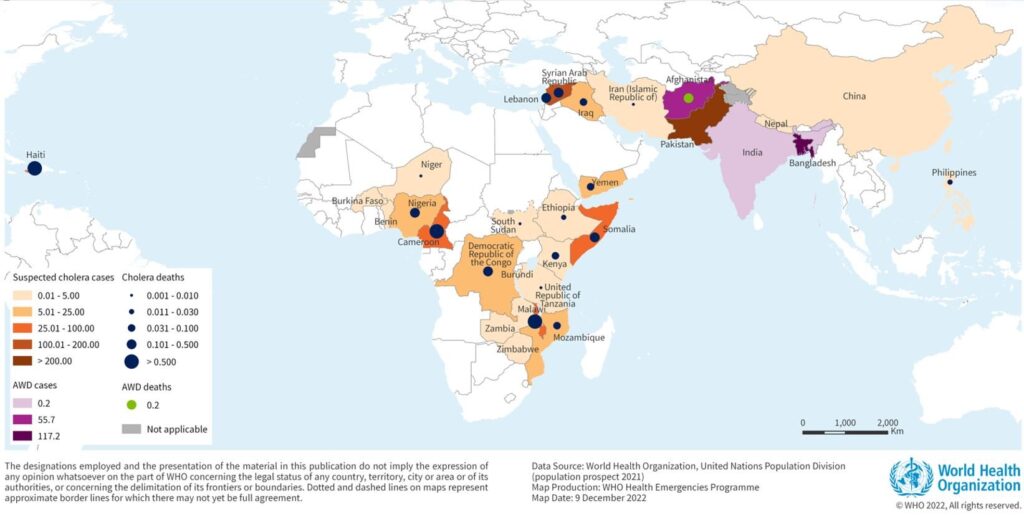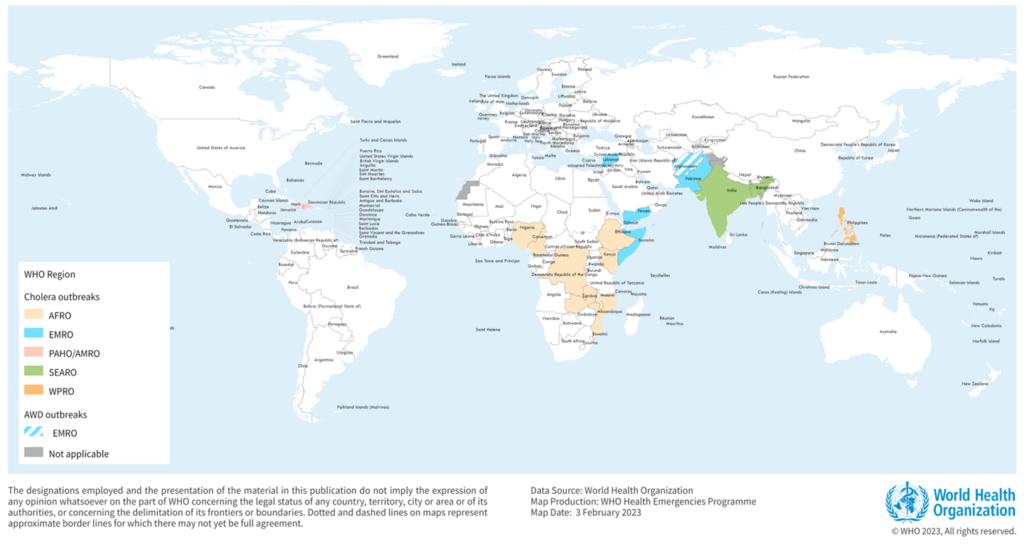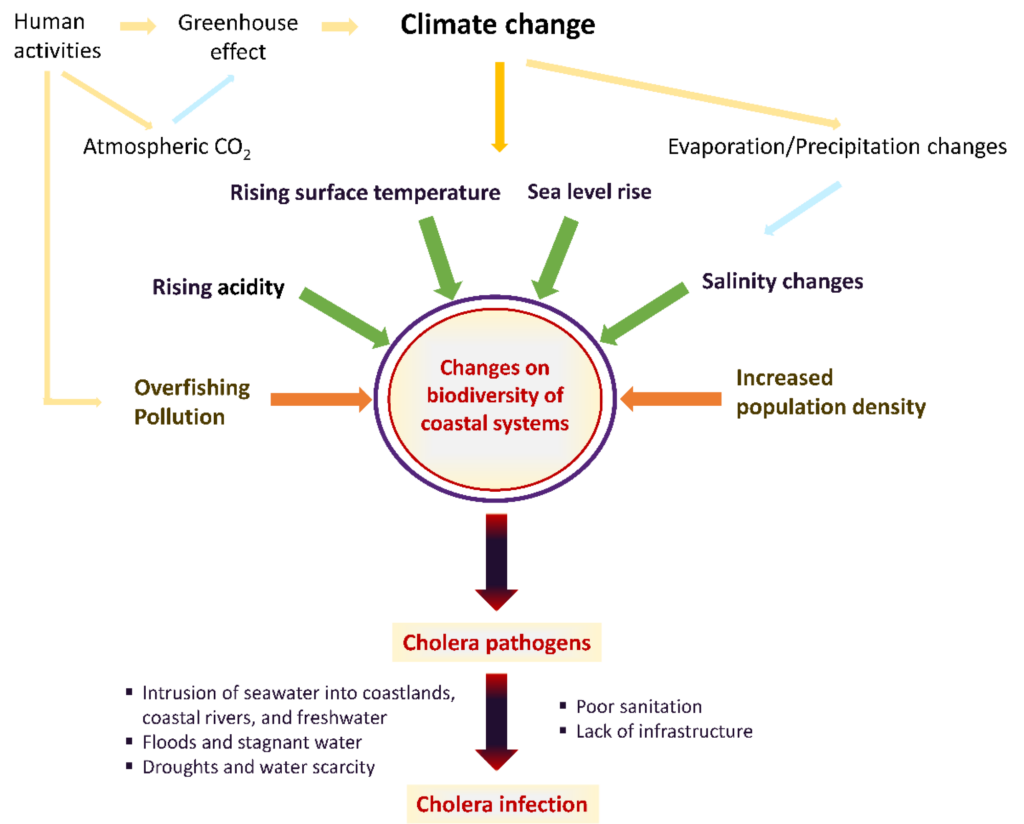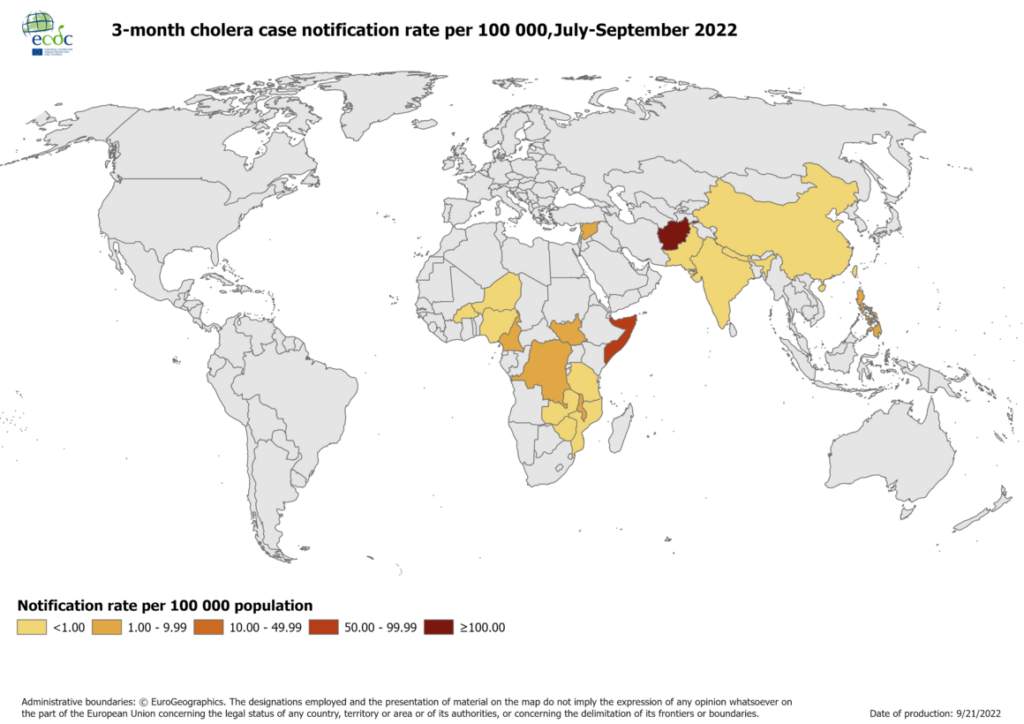Imagine a world where the threat of a deadly disease is ever-present, where outbreaks can rapidly spread across continents, causing widespread panic and devastation. This is the reality of cholera epidemics. With their global impact felt far and wide, these outbreaks have prompted urgent responses from governments, healthcare organizations, and communities around the world. In this article, we will explore the profound effects of cholera epidemics on a global scale and examine the various measures taken to combat this relentless foe. Together, we will unravel the complexities of this disease and discover the determination and resilience of humanity in the face of adversity. So, prepare yourself for an eye-opening journey into the world of cholera.

Causes and Spread of Cholera
Cholera, a highly infectious and deadly disease, is primarily caused by the ingestion of food or water contaminated with the bacterium Vibrio cholerae. This bacterium thrives in unsanitary conditions and is mostly found in areas with inadequate water and sanitation systems. Cholera can spread rapidly through communities and even become widespread through epidemics and pandemics if left unchecked. Understanding the causes and spread of cholera is crucial in devising effective control and prevention measures.
Historical Cholera Epidemics
First Cholera Pandemic (1817-1824)
The first documented cholera pandemic began in 1817, originating from the Ganges Delta in India. This outbreak quickly spread across Asia and reached Europe, Africa, and North America. It is estimated to have caused millions of deaths, showcasing the devastating impact of cholera on a global scale.
Second Cholera Pandemic (1829-1851)
The second cholera pandemic originated in India and spread to Europe, North America, and Africa. It was during this pandemic that the link between contaminated water sources and cholera transmission was established. The exploration of global trade routes and the expansion of colonial empires contributed to the rapid spread of the disease.
Third Cholera Pandemic (1852-1860)
The third cholera pandemic emerged in India and quickly spread to other parts of Asia and Europe. This pandemic had a significant impact on the development of modern public health measures, such as improving sanitation and hygiene practices.
Fourth Cholera Pandemic (1863-1875)
The fourth cholera pandemic originated in India and rapidly spread to Russia, Europe, and North America. It led to advancements in medical understanding and the development of isolation techniques to prevent the transmission of the disease.
Fifth Cholera Pandemic (1881-1896)
The fifth cholera pandemic, originating in India, spread to parts of Africa, Europe, and Latin America. This pandemic served as a catalyst for the implementation of public health interventions, including the construction of water and sanitation infrastructure in affected areas.
Sixth Cholera Pandemic (1899-1923)
The sixth cholera pandemic began in India and spread to Africa, Asia, and Europe. While advancements in science and medicine occurred during this pandemic, control and prevention measures continued to face challenges due to socioeconomic factors.
Seventh Cholera Pandemic (1961-present)
The ongoing seventh cholera pandemic emerged in Indonesia and soon spread to Africa, Asia, and the Americas. This pandemic highlighted the importance of international collaboration and the urgent need for effective prevention and control strategies in vulnerable communities.

Global Impact of Cholera
Cholera as a Global Health Threat
Cholera remains a significant global health threat, particularly in countries with poor water and sanitation infrastructure. The disease spreads rapidly, causing widespread outbreaks and potentially overwhelming healthcare systems. The impact of cholera goes beyond the immediate health consequences, as it contributes to economic hardship, hindering development and perpetuating the cycle of poverty in affected regions.
Regions Most Affected by Cholera
Cholera predominantly affects regions with limited access to clean water and sanitation facilities, typically found in low-income countries. Sub-Saharan Africa, South Asia, and parts of Latin America are among the regions most affected by cholera. Within these regions, marginalized communities and densely populated urban areas are especially vulnerable to cholera outbreaks due to overcrowding, inadequate sanitation, and limited access to healthcare.
Impact on Poverty and Development
Cholera has a significant impact on poverty and development. The disease often strikes the most vulnerable populations, exacerbating existing socioeconomic inequalities. In affected areas, outbreaks can disrupt livelihoods, hinder economic growth, and strain healthcare systems. The resulting economic and social burdens further entrench communities in poverty, making it crucial to address cholera as a global health priority.
Cholera’s Impact on Education and Economy
Cholera outbreaks can have severe consequences on education and the economy. When outbreaks occur, schools may need to close to minimize disease transmission, depriving children of their education. Additionally, the economic impact of cholera is substantial, as it affects both local and national economies. The loss of productivity due to illness and the diversion of resources towards healthcare and emergency response measures can have long-lasting repercussions on economic stability and development.
High-Risk Groups
Certain groups are more susceptible to cholera and its severe consequences. Pregnant women, malnourished individuals, and those with weakened immune systems are particularly vulnerable to the disease. Inadequate healthcare access and poor nutritional status exacerbate the impact of cholera on these high-risk populations. Efforts to control and prevent cholera should prioritize these groups to reduce morbidity and mortality rates.
Socioeconomic Factors
Poor Sanitation and Water Quality
Poor sanitation and water quality are key factors contributing to the spread of cholera. Inadequate sewage systems, open defecation practices, and contaminated water sources all increase the risk of cholera transmission. Addressing these issues requires investing in improved sanitation infrastructure, promoting proper waste management, and ensuring access to clean water sources.
Lack of Access to Health Care
Limited access to healthcare exacerbates the impact of cholera outbreaks. In many affected regions, healthcare facilities are scarce or inaccessible to those in need. Overcrowded hospitals and clinics struggle to provide adequate medical care during outbreaks, leading to higher mortality rates. Efforts to control cholera should prioritize strengthening healthcare systems and ensuring access to timely and appropriate medical care.
Poverty and Malnutrition
Poverty and malnutrition contribute to the vulnerability of communities to cholera outbreaks. Limited resources and access to nutritious food compromise immune function, making individuals more susceptible to contracting the disease and experiencing severe complications. Addressing the underlying causes of poverty and malnutrition is crucial in mitigating the impact of cholera and preventing future outbreaks.

Cholera Control and Prevention Measures
Ensuring Clean Water and Sanitation
Ensuring access to clean water and adequate sanitation facilities is essential in controlling and preventing cholera. Investment in water and sanitation infrastructure, improved waste management practices, and the promotion of hygiene behaviors, such as handwashing, contribute to reducing the transmission of the disease. Collaboration between governments, non-governmental organizations, and communities is vital in achieving sustained improvements in water and sanitation systems.
Promoting Hygiene Practices
Promoting good hygiene practices, such as handwashing with soap, is a fundamental preventive measure against cholera. Educational campaigns that raise awareness about the importance of hygiene, especially in vulnerable communities, can have a significant impact on reducing the transmission of the disease. Access to soap and adequate handwashing facilities should also be prioritized.
Early Detection and Rapid Response
Early detection and rapid response mechanisms play a crucial role in containing cholera outbreaks. Improving surveillance systems and training healthcare workers to recognize the symptoms of cholera can lead to early identification of cases and prompt implementation of control measures. Preparing emergency response plans and mobilizing resources in advance can help ensure a swift and effective response to outbreaks.
Vaccination Campaigns
Vaccination campaigns have proven effective in controlling cholera outbreaks. Oral cholera vaccines can provide short-term immunity, reducing the severity and duration of the disease. Targeted vaccination campaigns in high-risk areas and among specific populations can significantly curb the spread of cholera, especially when combined with other control and prevention measures.
Emergency Medical Care and Treatment
Timely access to emergency medical care and treatment is critical in reducing cholera-related morbidity and mortality. Rehydration therapy, which involves replacing fluids and electrolytes lost through diarrhea, is the cornerstone of cholera treatment. Health systems in affected regions should be equipped with the necessary supplies and trained healthcare professionals to provide appropriate care during outbreaks.
Global Response to Cholera Outbreaks
Surveillance and Monitoring Systems
Establishing robust surveillance and monitoring systems is crucial in detecting and responding to cholera outbreaks promptly. Improved data collection and analysis enable early identification of at-risk areas, helping prioritize resource allocation and response measures. Strengthening national and global surveillance networks allows for real-time monitoring and data sharing, facilitating a coordinated international response.
Multilateral Organizations’ Efforts
Multilateral organizations, such as the World Health Organization (WHO) and the United Nations Children’s Fund (UNICEF), play a crucial role in coordinating and supporting cholera control efforts. These organizations provide technical guidance, mobilize resources, and facilitate international cooperation to prevent and control cholera outbreaks. Their initiatives focus on strengthening health systems, promoting water and sanitation improvements, and expanding access to vaccination campaigns.
National and International Collaboration
Cholera control and prevention efforts require strong collaboration between national governments, international partners, and local communities. Sharing knowledge, resources, and best practices strengthens response mechanisms and improves the overall effectiveness of control measures. Cross-border cooperation and the development of regional strategies are particularly important in tackling cholera, as the disease respects no boundaries.
Capacity Building and Training Programs
Investing in capacity building and training programs is essential in enhancing the skills and knowledge of healthcare workers and frontline responders. Training initiatives can focus on case identification, laboratory testing, surveillance techniques, and effective communication strategies. Building local capacity to detect, respond to, and manage cholera outbreaks empowers communities to take an active role in preventing the spread of the disease.

Controversies and Challenges in Cholera Management
Challenges in Obtaining Accurate Data
Obtaining accurate data on cholera cases and outbreaks remains a challenge in many affected regions. Limited resources, weak surveillance systems, and underreporting contribute to the underestimation of the true burden of the disease. Overcoming these challenges requires investment in healthcare infrastructure, strengthening surveillance capacities, and improving data collection and reporting mechanisms.
Water and Sanitation Infrastructure Improvements
Improving water and sanitation infrastructure is crucial in preventing cholera outbreaks. However, implementing such improvements can be challenging due to financial constraints, political will, and logistical hurdles. Sustainable funding, government commitment, and community engagement are vital in achieving long-term improvements in water and sanitation systems.
Socioeconomic Inequalities and Access to Health Care
Socioeconomic inequalities contribute to disparities in access to healthcare, exacerbating the impact of cholera on vulnerable populations. Limited financial resources, lack of education, and social marginalization limit individuals’ ability to seek timely and appropriate medical care. Addressing these inequalities requires a multisectoral approach that prioritizes equitable access to healthcare and social welfare.
Vaccine Development and Implementation
While oral cholera vaccines have proven effective in reducing the impact of cholera outbreaks, vaccine development and implementation face challenges. Limited vaccine supply, cost, and logistics hinder widespread vaccination campaigns in high-risk areas. Continued investment in vaccine research, production, and affordability is necessary to ensure the availability and accessibility of vaccines to populations at risk.
Political Factors and Cholera Management
Political factors can significantly influence the management of cholera outbreaks. Political instability, conflicts, and inadequate governance can hinder effective control measures and impede international assistance. To overcome these challenges, political commitment and investment in public health infrastructure must be prioritized, allowing for a coordinated and robust response to cholera outbreaks.
Case Studies: Cholera Outbreaks and Responses
Cholera Outbreak in Haiti (2010)
The cholera outbreak in Haiti, starting in 2010, resulted in one of the largest epidemics in recent history. The introduction of the disease into the country was linked to contaminated water sources from a United Nations peacekeeping base. This outbreak highlighted the importance of improving sanitation infrastructure, enhancing response mechanisms, and ensuring accountability in the face of public health emergencies.
Cholera Outbreak in Yemen (ongoing)
Yemen has been experiencing one of the world’s largest cholera outbreaks since 2016. The ongoing conflict, weakened healthcare system, and limited access to clean water and sanitation have contributed to the rapid spread of the disease. Addressing the Yemeni cholera crisis necessitates a comprehensive approach that encompasses immediate humanitarian aid, long-term investments in water and sanitation infrastructure, and efforts to resolve the underlying conflict.
Cholera Outbreak in Zimbabwe (2008-2009)
Zimbabwe experienced a severe cholera outbreak from 2008 to 2009, resulting in thousands of deaths and widespread suffering. Political and economic instability compounded by poor water and sanitation facilities contributed to the rapid spread of the disease. The outbreak served as a wake-up call for the urgent need to invest in health infrastructure, strengthen governance, and address socioeconomic inequalities to prevent future outbreaks.

Lessons Learned and Future Outlook
Greater Investments in Water and Sanitation Infrastructure
To prevent and control cholera, greater investments are needed in water and sanitation infrastructure. Sustainable improvements in access to clean water sources and sanitation facilities are crucial to reducing the transmission of the disease. Governments, international organizations, and communities must work together to ensure adequate funding, implement infrastructure projects, and maintain long-term infrastructure sustainability.
Strengthening Health Systems
Strengthening health systems is essential in effectively responding to cholera outbreaks. This includes improving access to healthcare, training healthcare workers, and equipping healthcare facilities with necessary resources and supplies. A resilient health system allows for prompt detection, rapid response, and proper management of cholera cases, ultimately reducing the impact of outbreaks.
Improved Surveillance and Response Systems
Continued investment in surveillance and response systems is critical in controlling and preventing cholera. Enhanced data collection and analysis, coupled with real-time monitoring, enable early detection and timely intervention. Strengthening collaborative platforms between local, national, and international stakeholders promotes effective sharing of information, resources, and best practices during outbreaks.
Enhanced International Collaboration
Cholera is a global health threat that requires concerted international collaboration. Sharing knowledge, expertise, and resources across borders is vital in addressing the complex challenges posed by the disease. Collaborative efforts should focus on strengthening global surveillance networks, supporting research and development, and sharing lessons learned from successful cholera control and prevention programs.
Investment in Research and Innovation
Investments in research and innovation are necessary to improve cholera control and prevention strategies. This includes developing more effective vaccines, exploring alternative treatment modalities, and advancing diagnostic technologies. Research can also guide targeted interventions in high-risk areas and inform policy decisions, leading to more efficient resource allocation and better outcomes in cholera management.
Conclusion
Cholera, a preventable and treatable disease, continues to pose a significant global health challenge. Poor water and sanitation infrastructure, limited access to healthcare, and socioeconomic factors contribute to the spread and impact of cholera outbreaks. However, through concerted efforts in water and sanitation improvements, hygiene promotion, vaccination campaigns, and strengthened health systems, the global community can work together to control and eventually eliminate cholera. By addressing the root causes and implementing comprehensive strategies, the world can strive toward a future free from the devastating effects of cholera epidemics.